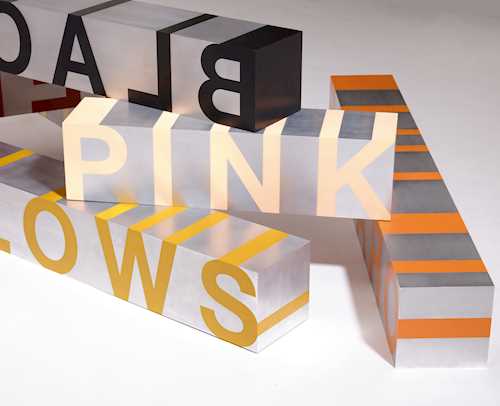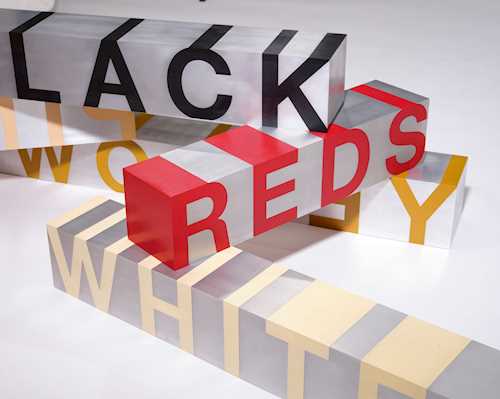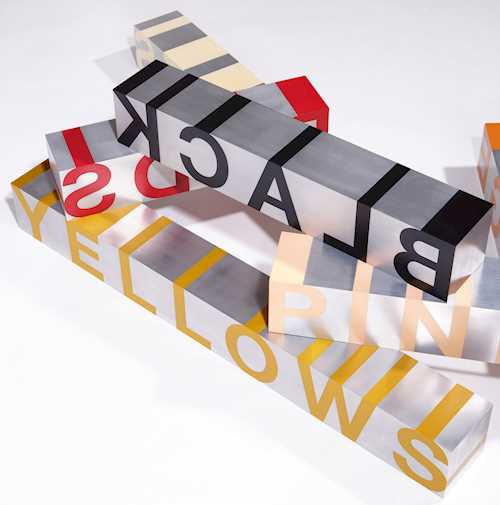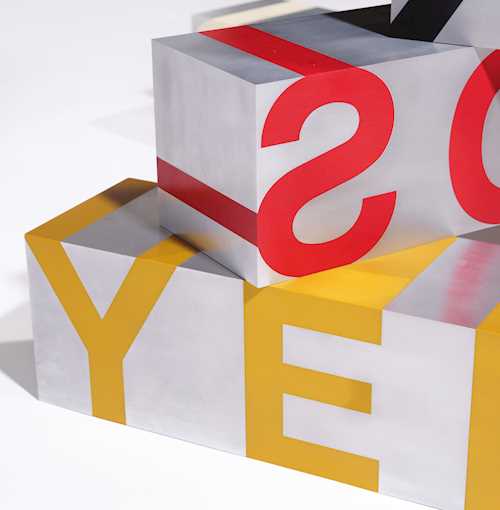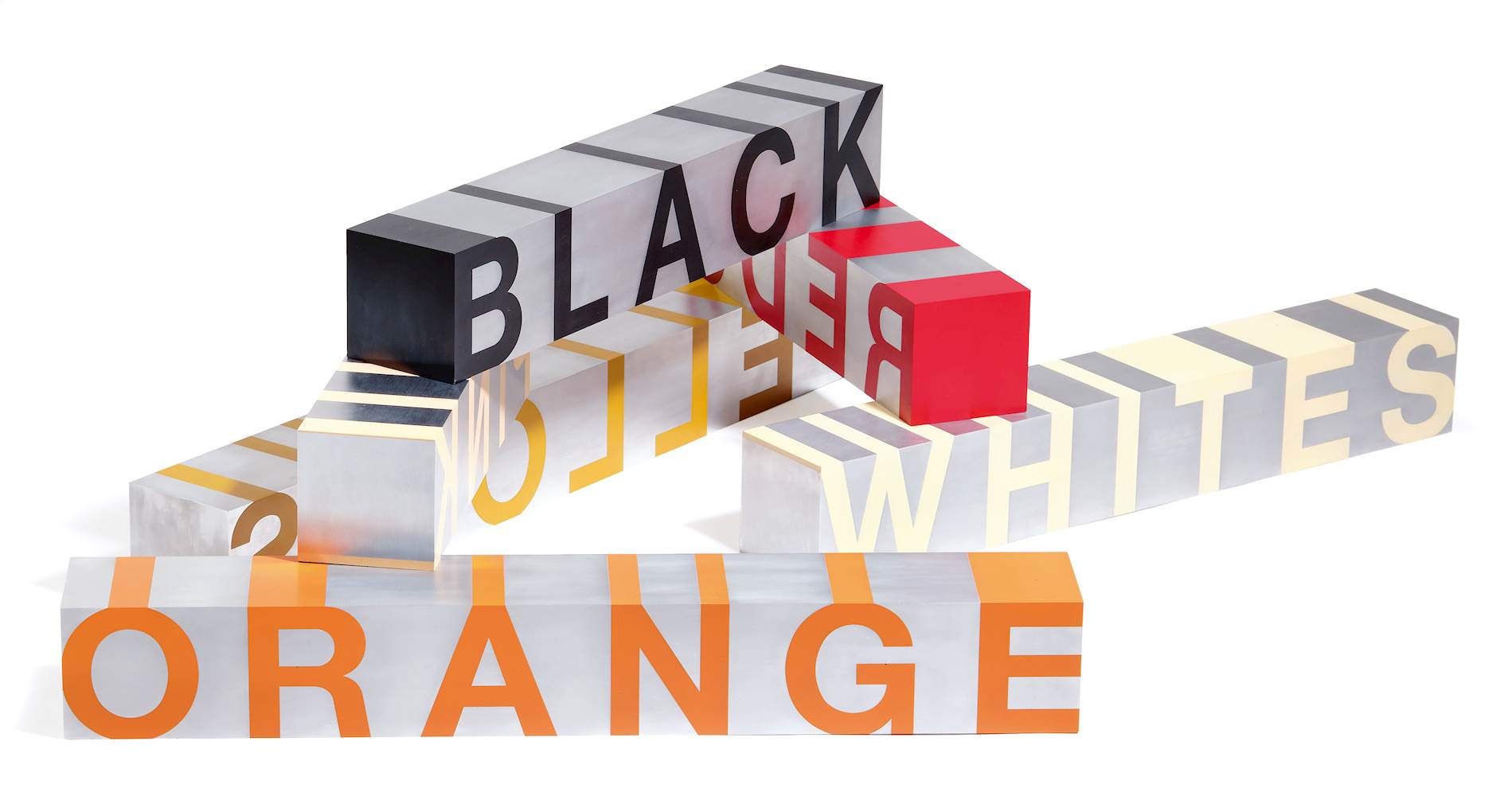
Lot 3406* - A211 PostWar & Contemporary - jeudi, 28. novembre 2024, 16h00
RONI HORN
(New York 1955–lives and works in New York)
Steven's Bouquet. 1991.
Solid aluminum and cast plastic, 6 units. 1/3.
160 × 120 × 38.5 cm (variabel installation).
Provenance:
- Private collection, acquired in the above gallery in 1992.
- Auction Sotheby's, New York, 18.11.1999, lot 102.
- Private collection, Switzerland, acquired at the above auction.
“The object is not the end; what I’m interested in is the experience it provides for—how it incites and animates dialogue”. Roni Horn
Roni Horn, born in New York in 1955, is a renowned American artist. She completed her design studies at the Rhode Island School of Design and later gained a Master of Fine Arts at Yale University. The great versatility of her oeuvre is evident not only in her choice of media, but also in the diversity of her content. Her works deal intensively with themes such as identity, change and the relationship between man and nature. Horn lives and works in both New York and Reykjavik - two contrasting environments that significantly inform her artistic practice.
Her minimalist works question traditional notions of form and perception. They emphasise that what you see does not always correspond to what you think you see. In her works, Horn succeeds in subtly breaking through established attributions and in bringing to light the dynamics of changeability and diversity. In doing so, she transcends the boundaries between the visible and the invisible. She often utilises materials such as glass or light metals as well as motifs such as water or the weather, which are inherently multi-layered and changeable. Despite this diversity, certain preferences emerge again and again in her work, in particular a sensitive examination of language and its cultural, social and poetic potential.
From the late 1980s onwards, Horn devoted herself to the poet Emily Dickinson and created several works inspired by her poems. One example of this is a series of narrow aluminium rods with white letters embedded in them and aligned vertically on walls. The word, which Horn had already explored before, now became the central subject and object of her art. The poet Wallace Stevens (1879–1955) is also one of the few literary figures who are repeatedly taken up in her work. Stevens, an important American poet of the 20th century, is known for his complex, philosophical poems, which often deal with the relationship between imagination and reality. His poetry is characterised by an elegance of form, rich imagery and philosophical depth. Many of his poems deal with themes such as the power of the human imagination, the nature of reality and the role of art. Stevens holds the view that the human imagination plays a central role in creating order and beauty in the chaos of reality.
The work ‘Steven’s Bouquet’ by Roni Horn, created in 1991, is, as the title suggests, a tribute to the poet. It is a minimalist yet deeply symbolic installation that refers to Stevens' poem “Bouquet of Roses in Sunlight”, written in October 1947. One example of this rare three-part edition is in the collection of the Museum of Modern Art in New York.
The rods of the installation are simple and industrial in design, which emphasises the formal rigour. The words encased in synthetic resin reflect the concept of language and reflection. This pared-down aesthetic creates connotations of clarity and precision. The structure of the installation and the choice of materials - aluminium and resin - are reminiscent of American minimalism, but at the same time the sensual experience is intensified by the contrast between the coolness of the aluminium and the sometimes delicate pastel shades of the letters. Viewing this sculpture opens up a wide array of associations that are not, however, directly predetermined by the artist. The work enters into an exciting dialogue between language and form. The title suggests something fleeting and ephemeral, while the material and the strict arrangement of the rods represent permanence and stability. The work thus invites the audience to reflect on the contrast between material reality and linguistic immateriality. Only a reading of Stevens' poem reveals the meaning of the words chosen in the work.
In brief, ‘Steven’s Bouquet’ creates a meditative space for the viewer through its reduced formal language, the integration of poetry and the exploration of existential themes. The interface between language, art and nature can be experienced here. Horn succeeds in translating Stevens' poem, which uses images of nature to convey abstract thoughts, into a material form. By choosing aluminium and synthetic resin - materials associated with modern technology and industry - she lends the work a timeless quality that embraces both the concrete and the abstract.
Bouquet of Roses in Sunlight
Say that it is a crude effect, black reds,
Pink yellows, orange whites, too much as they are
To be anything else in the sunlight of the room,
Too much as they are to be changed by metaphor,
Too actual, things that in being real
Make any imaginings of them lesser things.
And yet this effect is a consequence of the way
We feel and, therefore, is not real, except
In our sense of it, our sense of the fertilest red,
Of yellow as first color and of white,
In which the sense lies still, as a man lies,
Enormous, in a completing of his truth.
Our sense of these things changes and they change,
Not as in metaphor, but in our sense
Of them. So sense exceeds all metaphor.
It exceeds the heavy changes of the light.
It is like a flow of meanings with no speech
And of as many meanings as of men.
We are two that use these roses as we are,
In seeing them. This is what makes them seem
So far beyond the rhetorician’s touch.
Wallace Stevens
Roni Horn, born in New York in 1955, is a renowned American artist. She completed her design studies at the Rhode Island School of Design and later gained a Master of Fine Arts at Yale University. The great versatility of her oeuvre is evident not only in her choice of media, but also in the diversity of her content. Her works deal intensively with themes such as identity, change and the relationship between man and nature. Horn lives and works in both New York and Reykjavik - two contrasting environments that significantly inform her artistic practice.
Her minimalist works question traditional notions of form and perception. They emphasise that what you see does not always correspond to what you think you see. In her works, Horn succeeds in subtly breaking through established attributions and in bringing to light the dynamics of changeability and diversity. In doing so, she transcends the boundaries between the visible and the invisible. She often utilises materials such as glass or light metals as well as motifs such as water or the weather, which are inherently multi-layered and changeable. Despite this diversity, certain preferences emerge again and again in her work, in particular a sensitive examination of language and its cultural, social and poetic potential.
From the late 1980s onwards, Horn devoted herself to the poet Emily Dickinson and created several works inspired by her poems. One example of this is a series of narrow aluminium rods with white letters embedded in them and aligned vertically on walls. The word, which Horn had already explored before, now became the central subject and object of her art. The poet Wallace Stevens (1879–1955) is also one of the few literary figures who are repeatedly taken up in her work. Stevens, an important American poet of the 20th century, is known for his complex, philosophical poems, which often deal with the relationship between imagination and reality. His poetry is characterised by an elegance of form, rich imagery and philosophical depth. Many of his poems deal with themes such as the power of the human imagination, the nature of reality and the role of art. Stevens holds the view that the human imagination plays a central role in creating order and beauty in the chaos of reality.
The work ‘Steven’s Bouquet’ by Roni Horn, created in 1991, is, as the title suggests, a tribute to the poet. It is a minimalist yet deeply symbolic installation that refers to Stevens' poem “Bouquet of Roses in Sunlight”, written in October 1947. One example of this rare three-part edition is in the collection of the Museum of Modern Art in New York.
The rods of the installation are simple and industrial in design, which emphasises the formal rigour. The words encased in synthetic resin reflect the concept of language and reflection. This pared-down aesthetic creates connotations of clarity and precision. The structure of the installation and the choice of materials - aluminium and resin - are reminiscent of American minimalism, but at the same time the sensual experience is intensified by the contrast between the coolness of the aluminium and the sometimes delicate pastel shades of the letters. Viewing this sculpture opens up a wide array of associations that are not, however, directly predetermined by the artist. The work enters into an exciting dialogue between language and form. The title suggests something fleeting and ephemeral, while the material and the strict arrangement of the rods represent permanence and stability. The work thus invites the audience to reflect on the contrast between material reality and linguistic immateriality. Only a reading of Stevens' poem reveals the meaning of the words chosen in the work.
In brief, ‘Steven’s Bouquet’ creates a meditative space for the viewer through its reduced formal language, the integration of poetry and the exploration of existential themes. The interface between language, art and nature can be experienced here. Horn succeeds in translating Stevens' poem, which uses images of nature to convey abstract thoughts, into a material form. By choosing aluminium and synthetic resin - materials associated with modern technology and industry - she lends the work a timeless quality that embraces both the concrete and the abstract.
Bouquet of Roses in Sunlight
Say that it is a crude effect, black reds,
Pink yellows, orange whites, too much as they are
To be anything else in the sunlight of the room,
Too much as they are to be changed by metaphor,
Too actual, things that in being real
Make any imaginings of them lesser things.
And yet this effect is a consequence of the way
We feel and, therefore, is not real, except
In our sense of it, our sense of the fertilest red,
Of yellow as first color and of white,
In which the sense lies still, as a man lies,
Enormous, in a completing of his truth.
Our sense of these things changes and they change,
Not as in metaphor, but in our sense
Of them. So sense exceeds all metaphor.
It exceeds the heavy changes of the light.
It is like a flow of meanings with no speech
And of as many meanings as of men.
We are two that use these roses as we are,
In seeing them. This is what makes them seem
So far beyond the rhetorician’s touch.
Wallace Stevens
CHF 120 000 / 180 000 | (€ 123 710 / 185 570)





